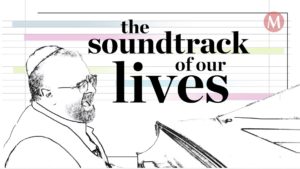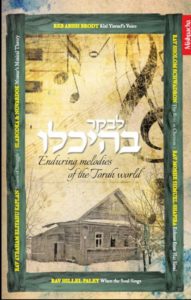Worth a 1000 Words

Have you read The Terrible Trap of the Bad Middos Pirates? Or A Never-Ending Tale? Did the illustrations transport you into a different world? If you’ve ever flipped through one of Gadi Pollack’s books — and chances are, you have! — you’ll know that he’s one fantastic artist. Whether the pictures are comic or lifelike, his work is a result of remarkable talent given to him by Hashem, combined with lots of hard, painstaking effort. We caught up with Gadi in his small studio in Kiryat Sefer, Israel, and asked him to paint a picture for our readers of what it’s like to be an artist.
MJ: Thanks so much for meeting with us. Many of our readers are aspiring artists — just take a look at our Readers' Gallery. Were you an artist as a child?
GP: Like all kids, I colored on the walls. But unlike other kids, I never stopped! I grew up in Odessa, in the Ukraine, and my parents wanted me to learn an instrument and become a musician like the rest of my family. But I wasn’t interested. All I wanted to do was paint. Finally, my father agreed to let me go to a special school and learn art. I studied for four years in art school and another four at an art academy.
MJ: So did you start illustrating right after you finished school?
GP: No. It took me many years and a lot of moving around the world until I finally settled in Eretz Yisrael and thought about starting to illustrate. My friend, Yoni Gerstein, suggested that I try illustrating, so I did. My first book was called Tell Me What You Think, about a family and the different things they experience in their lives. After a couple of other books I met up with Rabbi Baruch Chait and we decided to work together to create the “Gaavatanic” series.
MJ: We love the “Gaavatanic” series! Was that a big project to tackle?
GP: You bet! In order to draw the Gaavatanic ship, I studied dozens of pictures and read many books about the Titanic, the ship the Gaavatanic is based on. I knew that Titanic by heart, down to the last nail!
MJ: When you draw characters, do you copy real people or do you use your imagination to make them up?
GP: Well, a lot of the time I do base a character on a real person. If you knew what I looked like you might even be able to find a character that looks like me in one of my books! In Once Upon a Tale, for example, Zalman, the rich man, is based on Baron Rothschild. Take a look and see if you notice a resemblance. But my characters go through a lot of revisions. I start out with a rough sketch, then I change it and change it some more until it’s just right. Rebbe Lev Tov, the beloved rebbe in the “Middos Series,” started out very different from the way he ended up. I can even show you all the different drawings we went through until we came up with the “perfect” character. [Here, Rabbi Pollak pulls out a massive pile of sketches. I see that Rebbe Lev Tov started out looking very different from his wonderful, cheery self. He got rounder, smilier, and altogether more kind and gentle-looking as the sketches get flipped!]
MJ: How about when you draw places or other objects, like the train in the “Once Upon a Tale” series?
GP: All these images and buildings are based on real things, either from real life or from pictures. Some of them portray places that I remember from my life in Russia. For example, the building with the huge sundial on it featured in The End of the Tale is an actual building on Yaffo Street in Yerushalayim. I try to have every element in every illustration capture every last detail so that it’s as realistic as possible.
MJ: I’m sure that takes a lot of time and research!
GP: Of course. I spend lots and lots of time doing research for my books — looking at pictures, reading up on things, and, of course, in the Otzar Sefarim where I researched material for books like PurimShpiel and the Haggadah I created together with Rabbi Baruch Chait. And the drawing itself is painstaking and involves many steps.
MJ: How do you get your ideas for the books you’ve created?
GP: Well, with PurimShpiel, it was my chavrusa, the famous comics artist Dovid Goldschmidt, who had the idea of doing a comic book where lots of things are happening on one large page instead of in smaller strips like in standard comics. He suggested I do this with Megillas Esther, but I insisted it wouldn’t work. Then I decided to give it a try and I was amazed. I had incredible siyata d’Shmaya — the project, which included a lot of research of midrashim and, of course, lots of drawing, was completed in just two months! The “Once Upon a Tale” series came into being one day when I was suddenly struck by the thought that while many Jewish authors make up their own stories, we are fortunate to have a vast number of beautiful tales told to us by Chazal — and with such inspiring messages! Why not turn those stories into a book? That’s why I created the series, which is based on the meshalim, parables, of the Dubno Maggid.
MJ: Well what you’re doing is definitely working! Have you ever had a really funny thing happen in one of your projects, or a real scare?
GP: Actually, when Rabbi Chait and I were working on creating the Pesach Haggadah, we were on a very tight deadline. We had to get the books shipped to America in time for them to be sold before Pesach. The pages had already been printed and were waiting to be bound. Suddenly, we discovered that by accident, Hallel had been printed after Bircas HaMazon! Oy! We opened up all the 10,000 booklets by hand, printed up new pages, bound and glued them. Then we had to sew all the little booklets together — because a book is made up of many smaller, bound booklets — and put the covers on. The ship was supposed to leave on Sunday and it was Thursday. We worked all day Friday, stopped a few hours before Shabbos, started working feverishly again on Motzaei Shabbos, but we were nowhere near done. At 5 a.m. on Sunday morning, Rabbi Chait realized there was no way we would be able to make the deadline. He called the shipping company to cancel the shipment. It was a huge loss for us because it meant that the Haggadah wouldn’t be sold that year. As he was on the phone, Rabbi Chait heard someone beeping in several times on the call-waiting. It was the shipping company. “Sorry,” the representative of the shipping company said, “there was a port strike yesterday and the ship was delayed. Do you want to bring the books in tomorrow morning?” It was a miracle! There would be time to finish the Haggados and get them to the port, because the ship was only going to leave a day later. The Haggadah was shipped all over the world and many, many people bought it in time for Pesach.
MJ: It sounds like you’ve had a lot of siyata d’Shmaya in your work. Can you tell us what new projects you’re working on?
GP: I’m always working on new projects, but I keep them secret until they’re published. You’ll just have to wait and see!
Gadi uses his artistic gifts to teach Torah and mitzvos to children and adults alike. A secular newspaper once interviewed him about his work. The reporter told him that he should be creating pictures just because they are beautiful, not because you want to teach lessons through the pictures.
This is what Gadi Pollack told the reporter:
“There are two friends. Each one has a fork. Each friend has a schnitzel on their fork. One friend finishes his schnitzel and throws his fork in the garbage. The other friend takes his fork and decorates it, frames it, and displays it! In fact, he starts yelling at his friend, ‘How dare you throw your fork in the garbage?! Why are you even eating schnitzel off that special fork?’ Of course, we would all think this man is acting very strange. Everyone understands that the fork is just a kli, a tool, while the schnitzel is the true matarah, the real purpose. When the schnitzel is finished, the fork gets thrown in the garbage — it has no other value. Art is the same way. In and of itself, art doesn’t mean much — it’s just a fork. But when you use art for a higher purpose, like to teach about middos and mitzvos, that’s when art is powerful and beautiful.”
For all of us who have enjoyed Gadi’s illustrations, it is clear that he is doing a wonderful job of giving his readers both a beautiful “fork” and a satisfying, long-lasting “schnitzel”!
(Originally featured in Junior, Issue 376)
Oops! We could not locate your form.












